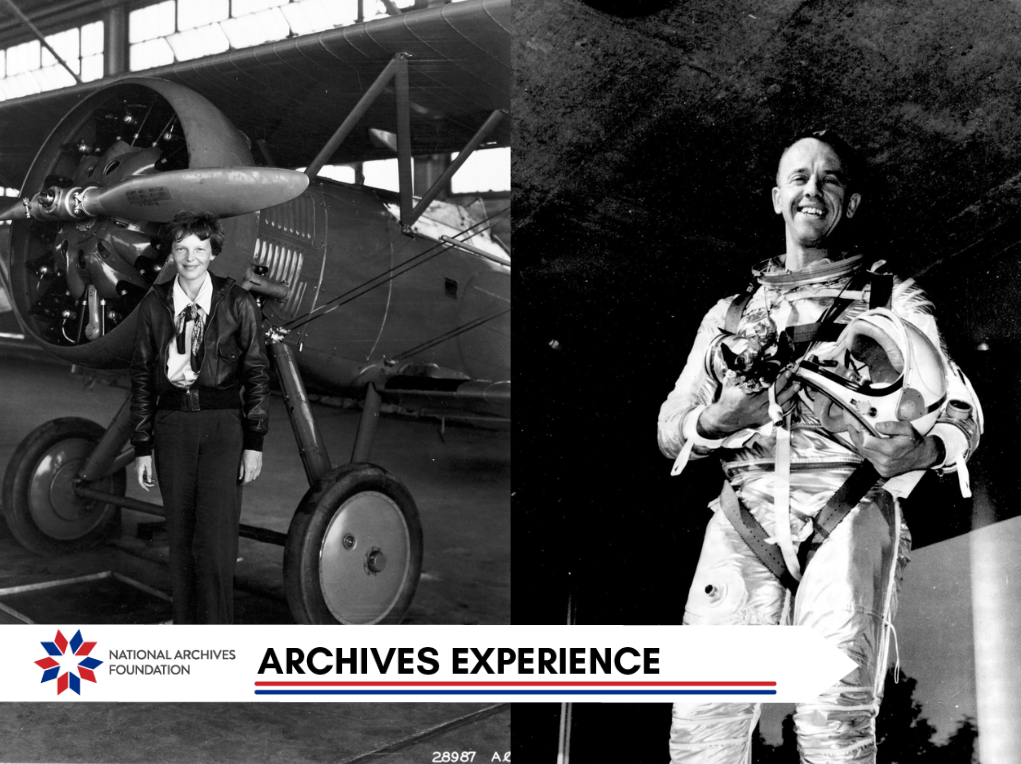Soaring: Pioneers of American Aerospace

62 years ago this May, U.S. Astronaut Alan Shepard set an historic era of American aerospace into motion with his journey aboard the Mercury capsule Freedom 7. Launch into his legacy and the iconic Americans who eventually brought us into the space age…
In this issue
Up, Up, and Away
On May 5, 1961, mere weeks after Soviet cosmonaut Yuri Gagarin reached outer space aboard Vastik I, Alan Shepard became the first American in space. In his short 15-minute flight aboard the Mercury capsule Freedom 7, he forever changed the possibilities for American flight and exploration. In celebration of the 62 years since this iconic flight, check out some of the pivotal firsts in flight that sparked our imaginations and led to innovations that shaped the world of aerospace.

Project Mercury – Successful flight by astronaut Alan Shepard
National Archives Identifier: 354845733

Astronaut Alan E. Shepard, Jr.
National Archives Identifier: 7430728

Launch of first American in space – Alan Shepard
National Archives Identifier: 354845765
Pioneers of Flight
Two Dayton, Ohio-based bicycle shop owners may seem like unlikely pioneers in aeronautics, but Orville and Wilbur Wright defied all expectations in the early 20th century. Piloted by Orville, the Wright Flyer took to the air in Kitty Hawk, North Carolina, on December 17, 1903. On the first of four flights that day, the Wright Flyer soared to 180 feet for only 12 seconds. By the final flight of 852 feet in 59 seconds, the Wright brothers had ushered in the age of aviation. Unfortunately, strong wind gusts damaged the Flyer, and it never took off again. The patent for their flying machine resides in the records of the National Archives.

Flying Machine – Wright Brothers
National Archives Identifier: 2524937

Wright Brothers’ 1903 Aeroplane Kitty Hawk in First Flight
National Archives Identifier: 7580929
Going Global
On April 6, 1924, a team of eight pilots in the U.S. Army took off from the Sand Point Naval Air Station in Seattle, Washington, in an attempt to be the first to circumnavigate the globe by air. They started with four aircraft named Seattle, Boston, Chicago, and New Orleans. The Seattle crashed shortly after the trip began, and after the Boston sank near the coast of Iceland, it was replaced by the Boston II. The remaining three aircraft completed the journey, arriving back where they started after 175 days and stops in 22 countries. Learn more about this achievement in this video from the National Archives.
The First Round-the-World Flight
(2 minutes 24 seconds)
Source: US National Archives YouTube Channel
Breaking More than One Barrier
Charles Lindbergh and Amelia Earhart will forever be remembered for their daring feats of aviation. On April 1, 1927, Lindbergh made history with his solo transatlantic flight aboard the Spirit of St. Louis, proving the viability of long-distance air travel. He flew from Long Island to Paris in 33.5 hours. Five years later to the day, Earhart flew solo across the Atlantic Ocean in 1932, the first American woman to do so. Her flight took her from Grace Harbor, Newfoundland, to Londonderry, Northern Ireland, in 15 hours. This monumental feat earned her the Army Air Corps Distinguished Flying Cross from the U.S. Congress. President Herbert Hoover presented her with the gold medal of the National Geographic Society for the achievement.

Charles Lindbergh and The Spirit of St. Louis after Landing in Paris
National Archives Identifier: 7580923

Amelia Earhart
National Archives Identifier: 6708609
A New Age
On the 20th anniversary of Yuri Gagarin’s voyage to space, U.S. Commander John Young and pilot Robert Crippen led the inaugural flight of the Space Shuttle Columbia on April 12, 1981. Designed to repeatedly carry astronauts and cargo into orbit, the shuttle represented a new age of space travel. In its 37 orbits around the earth, it completed all planned mission objectives and went on to serve in the NASA fleet for 22 years. Although it tragically exploded on reentry during its final mission, the legacy of the Columbia lives on. The shuttle program completed 135 missions.

The launching of the space shuttle Columbia
National Archives Identifier: 6342854

The space shuttle Columbia is rolled into a hangar
National Archives Identifier: 6344104
From the windswept beaches of Kitty Hawk to the vast expanse of space, each aerospace milestone represents a step further in our quest to explore the unknown. Every new innovation, every goal reached, every discovery made proves that for Americans, the sky is not the limit.



